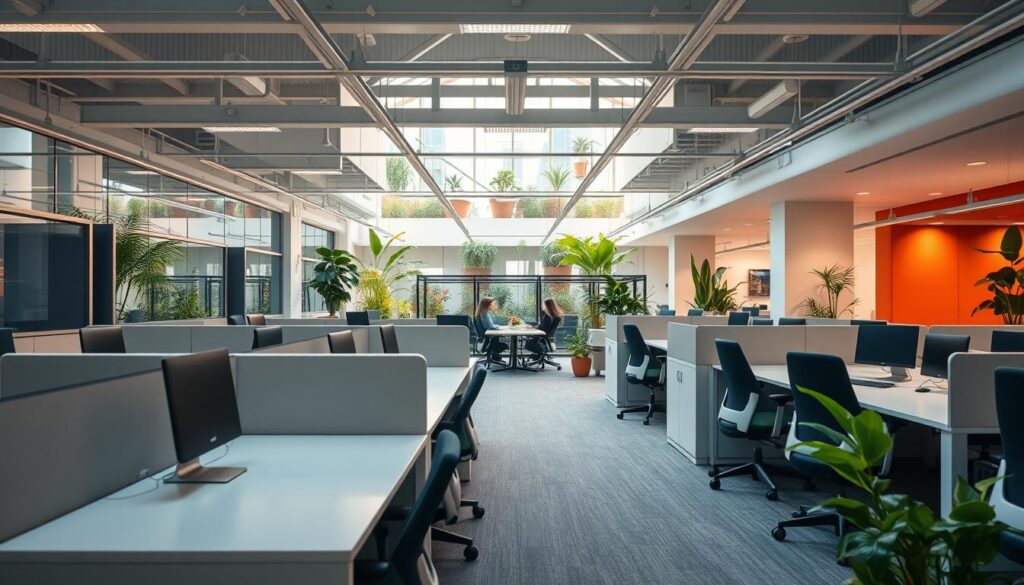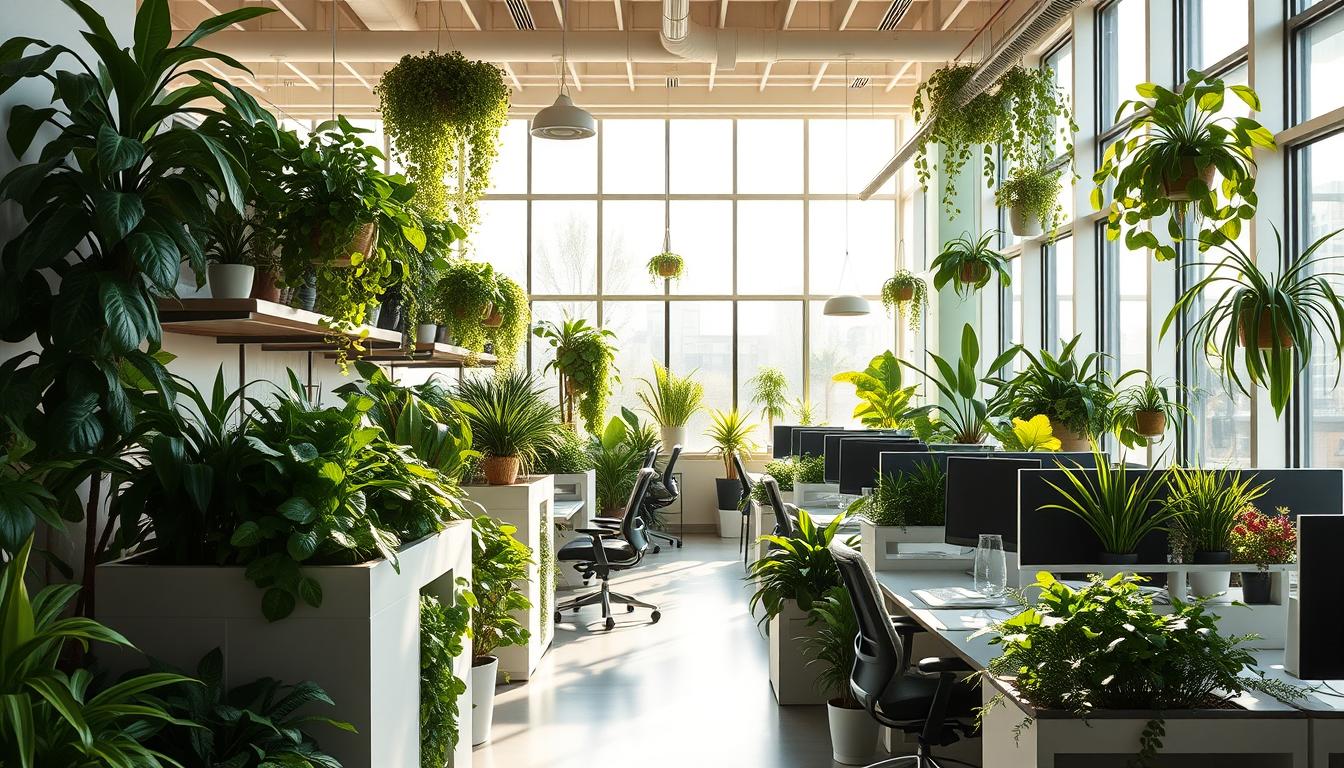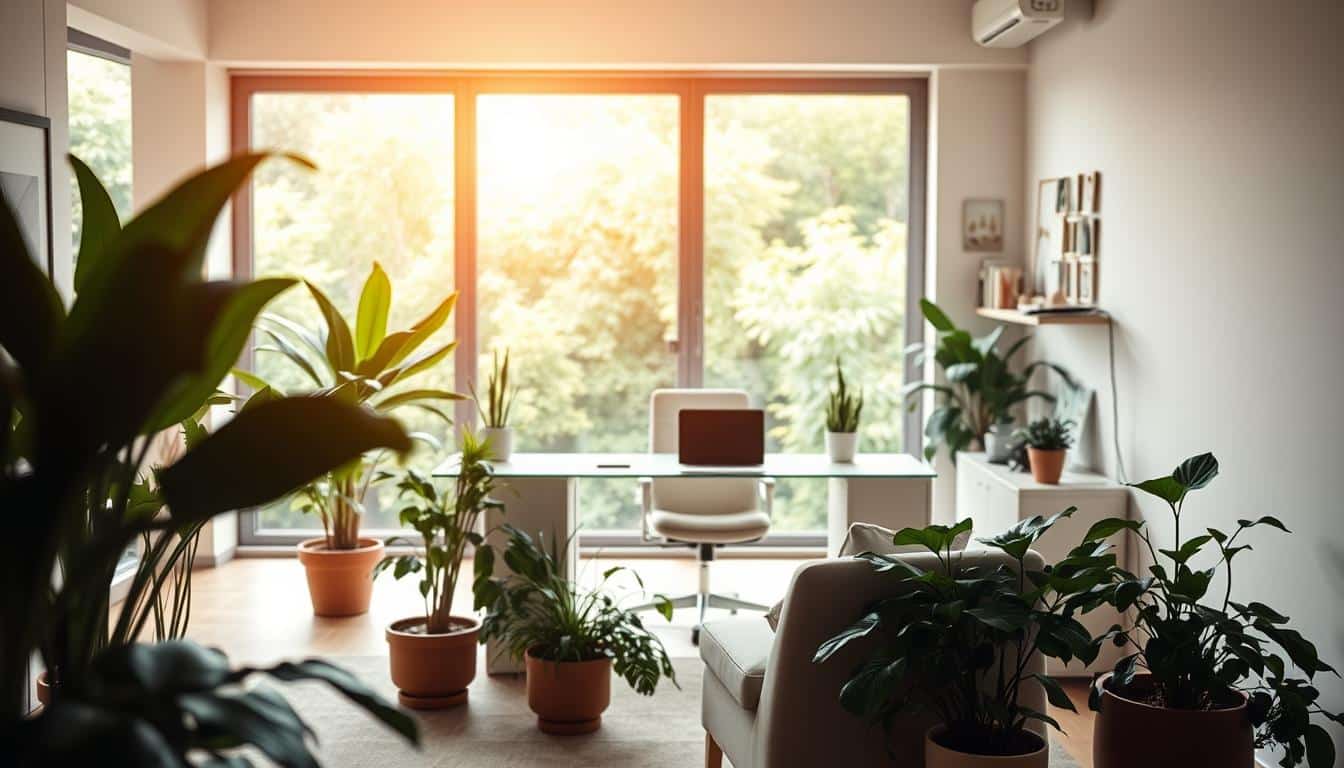As 2026 gets closer, office design is changing a lot. This change focuses on bioadaptive office environments. These spaces focus on keeping employees productive and happy. They use eco-friendly design principles.
These offices change to meet people’s needs and the environment. This new direction in design focuses on the people using the space. It makes work better and builds a healthy, productive culture. This is a fresh start for office design.
The Evolution of Office Design
The way offices look and feel has changed a lot because of cultural shifts and new tech. Workplaces used to be divided and fixed, but now they’re becoming more open and flexible. This change meets the needs of today’s workers and keeps up with our quick-moving world.
Shifting Cultural Values and Technological Advancements
People now want to work remotely and in teams, which changes what we expect from offices. We value creativity, community, and balancing work with life more than ever. So, companies are making spaces that boost teamwork and can change as needed. New tech in offices makes it easier for people to work together, even from far away.
Transition from Static to Dynamic Environments
Offices are moving from fixed designs to spaces that can change based on what people need. Today’s office design features areas that have many uses and furniture that can be adjusted. This focus on flexibility helps companies keep their employees happy and more productive. It shows how work culture and society itself are evolving.

What are Bioadaptive Office Environments?
Bioadaptive office environments are changing the way we think about workspaces. They aim to make settings that change according to what employees need. These places pay attention to what people physically and mentally need. This allows their workspaces to adapt in real-time.
By using new technologies and design ideas, bioadaptive environments make the workplace better. They do this by making sure things like light, heat, and noise match our natural rhythms.
Defining Bioadaptive Office Environments
The main idea of bioadaptive office environments is being able to adapt. They have features that help the workspace and its users interact. This means they use smart systems that can change settings to make people more comfortable and productive.
With a focus on responding to needs, these environments suit each person. They also help everyone work better and more efficiently.
The Benefits of Adaptivity in Workspaces
The good things about bioadaptive environments go beyond just looking nice. These benefits include:
- Making employees more comfortable with custom climate and light settings.
- Helping people work better as spaces change for different tasks.
- Improving mental and physical health with supportive environments.
When companies use these adaptive features, they see a happier and more effective team. Aligning with human needs is key to creating a lively and successful workplace.
Chronobiological Lighting Systems
Chronobiological lighting systems sync environments with our natural sleep-wake cycles. They shed light on how our daily lives, especially at work, are impacted. They make work spaces that support our body’s needs. This helps employees a lot.
Understanding Circadian Rhythms
Circadian rhythms are like our internal clocks. They manage our sleep and wakefulness, affecting our body and brain functions. When lighting matches these rhythms, it can boost health and work productivity. Morning light makes us more alert and improves our mood, making the workplace better.
The Impact of Light on Productivity and Well-Being
Chronobiological lighting changes light based on the time of day. This helps everyone work their best and feel good. The benefits are big:
- Workplace productivity goes up because people can focus better and are more engaged.
- Employee health gets better with quality sleep from the right light exposure.
- Natural light patterns help lower stress levels.
Using these systems creates a happier place to work. It boosts morale and efficiency. Putting money into chronobiological lighting improves the work setting. It also promotes a health-first culture for everyone.
Adaptive Acoustic Architecture
In today’s office design, adaptive acoustic architecture is key. It makes spaces more functional and improves user experience. By managing sound, these places easily change from lively social spots to quiet work areas. This changeability supports different tasks, like team brainstorming or solo work.
Managing Acoustic Properties in Office Spaces
Office environments now have sound management systems for real-time sound adjustments. These systems, using advanced tech like adjustable sound systems and barriers, meet employees’ varied needs. They boost productivity and make people happier at work.
Create Spaces for Different Activities
Creating areas for various tasks means planning carefully. Using movable partitions, sound-absorbing materials, and smart layouts helps. These efforts allow for both teamwork and individual focus, helping everyone do their best.
Responsive Material Systems
Responsive material systems are changing how office spaces adjust to new conditions. These materials change their features based on external changes. This makes offices more functional and enjoyable.
They boost comfort and air quality inside. This is a big leap forward for modern workplaces.
Integration of Smart Materials
Smart materials are key to these systems. They change their state to match the environment. For example, they can keep the inside temperature comfy by changing their insulation.
This means less energy used. Which makes offices more eco-friendly.
Impact on Thermal Comfort and Air Quality
Using these materials helps control temperature and air quality. They keep conditions just right, making the workspace nicer. Plus, some can filter the air or break down pollutants.
This leads to a healthier place for everyone. In the end, smart materials make offices better and more efficient.
Spatial Computing in Modern Offices
Spatial computing is changing the way we design offices today. It mixes physical spaces with digital tools. This mix makes offices more interactive, which helps people work better together. Digital tools are leading this change, turning regular offices into dynamic spaces that change to meet our needs.
Blending Physical and Digital Spaces
Spatial computing is erasing the line between real and digital worlds. This creates more unified offices. With things like real-time sharing, augmented reality, and easy connectivity, employees can interact with their surroundings in new ways. Thus, the office becomes a flexible place that boosts creativity and work efficiency.
Understanding Ambient Computing Surfaces
Ambient computing makes walls, furniture, and counters touchable screens. These smart surfaces change based on what the user needs. They can show information, help with communication, or manage tasks. This technology makes learning and working together better, showing how digital offices can be powerful.
Bioadaptive Office Environments
The modern workspace is changing with the trend of bioadaptive design. This approach focuses on creating spaces that support employees’ health and productivity. Many organizations are now shaping their offices with this in mind. These changes are proving to be beneficial for both work efficiency and well-being.
Case Studies in Bioadaptive Design
Several case studies show how bioadaptive design is put into practice. For instance, Google and Microsoft have embraced lighting that changes with the day to improve mood and comfort. These examples give us a clear view of the good effects such designs can have.
- Google: Their offices have lighting that works with our natural body clocks, helping people work better and feel good.
- Microsoft: They offer flexible spaces and smart furniture, making team work and comfort easier to achieve.
- Steelcase: This company makes furniture that can change in sound and sight settings, fitting various tasks and preferences.
Industry Leaders Implementing Bioadaptive Solutions
Big companies are leading the way in bioadaptive design. They use new tech to make offices that are more lively and healthy. Their focus on looking after the well-being of employees is part of a bigger move towards meeting each person’s unique needs at work.
- Apple: Their new place uses fresh air and natural light to make the work scene better and more engaging.
- Amazon: This company uses design that changes for noise and how open spaces are, suiting different ways of working.
- Adobe: They emphasize health with natural design features, which boosts imagination and thinking skills.
Regenerative Design Systems
Our world is moving towards being more eco-friendly. Regenerative design systems are at the heart of this change. They do more than just aim to reduce harm to our environment. They actively improve ecosystems. Through this, architects and designers can make office spaces that truly benefit the earth.
Moving Beyond Sustainability
Regenerative design takes office building to a new level. It involves using systems that help our planet stay healthy. This approach stresses the need for building materials that capture carbon. This way, the construction and use of office spaces help improve the air we breathe. Innovative methods make sure these spaces work in harmony with nature. They also encourage people working there to care for the environment.
Carbon-Sequestering Materials in Office Design
Using materials that catch and store carbon is a modern step in office design. These include:
- Bio-based composites like hempcrete.
- Recycled concrete that traps more carbon.
- Timber from forests that are looked after well.
This approach shows a company’s dedication to being eco-friendly. It also lowers their carbon emissions. Designing with these principles helps offices not just work well but also aid in healing our planet. They become part of the solution to environmental restoration.
Wellbeing-Centered Design Principles
Wellbeing-centered design focuses on mental and physical health together. It shapes workspaces with natural light, plants, and flexible layouts. This setup supports employee health and happiness. Studies show thoughtfully designed spaces lead to better health outcomes. So, applying wellbeing design is key in today’s offices.
Enhancing Mental and Physical Health
Using wellbeing design in offices boosts health and productivity. For instance, biophilic design brings nature inside, cutting stress and boosting calm feelings. Also, active design options like sit-stand desks get people moving. This approach helps both mind and body, making a balanced work life possible.
The Relationship Between Space and Well-being
The link between space and well-being matters a lot for effective workplaces. Good design can make us more focused and creative. Bad design might distract or disconnect us. Well-designed spaces, with areas for teamwork and quiet work, make employees healthier. This also leads to a company performing better.
Digital Fabrication Technologies
Digital fabrication technologies have changed how we design office spaces. These tools let designers create custom features for specific needs. They increase happiness for users and cut down on waste during production.
Economic Benefits of Personalized Production
Putting money into digital fabrication brings big financial perks for companies:
- They save money by using less material.
- They can make custom designs faster, making clients happy sooner.
- They can change designs quickly based on what clients want.
This tech leads to making more products close to home. It lowers shipping costs and is better for the planet.
Customization and Waste Reduction
Digital fabrication makes it easier to create exactly what an office needs. By doing so, it avoids using too much material. This is a big step towards using less resources:
- Designs are made precisely, leaving little leftover scraps.
- Creating just what is needed helps prevent too much production.
- Software simulations before making something reduce mistakes and waste.
Using these technologies helps companies hit their design targets. At the same time, it supports environmentally friendly practices in architecture.
Real-World Applications: Successful Projects
Bioadaptive design in offices has brought many successful projects to life. These stories prove the power of such designs. They have made workplaces look better and also helped people feel and work better.
Transformative Workplace Environments
Around the globe, companies are using bioadaptive ways to make workplaces better. For example, a leading tech company introduced lights that match our natural body clocks. This change made workers more focused and happier at their jobs.
- Open office designs that adjust sound levels help people work together but keep noise low.
- Natural materials make the air inside better, boosting creativity and lowering stress.
- Changing the environment based on what employees say makes everyone more comfortable and productive.
Outcome Measurements: Productivity and Satisfaction
Bioadaptive environments show their value by improving work and making people happier. Firms that chose this path saw their performance numbers go up. Studies show these environments lead to:
- A 20% boost in how much work gets done, thanks to better focus and less tiredness.
- More employees staying longer because they feel like they matter and are part of the team.
- Lots of positive comments, with 85% of workers happy with their new workspaces.
Conclusion
This article shows how bioadaptive design can change future offices. Using smart lights, sound designs, and special materials helps focus on health at work. These new ideas make workers happier and more productive, which is key today.
The link between our health and where we work is huge. As needs and challenges change, companies must keep up by investing in smart technology. Bioadaptive design is more than a trend; it’s a big step to making better workspaces that care for people and are efficient.
We need to keep our eyes open and be ready to improve how we design offices. By choosing bioadaptive settings, we prepare for workspaces that really fit what people need. They also help us get along better with nature.



